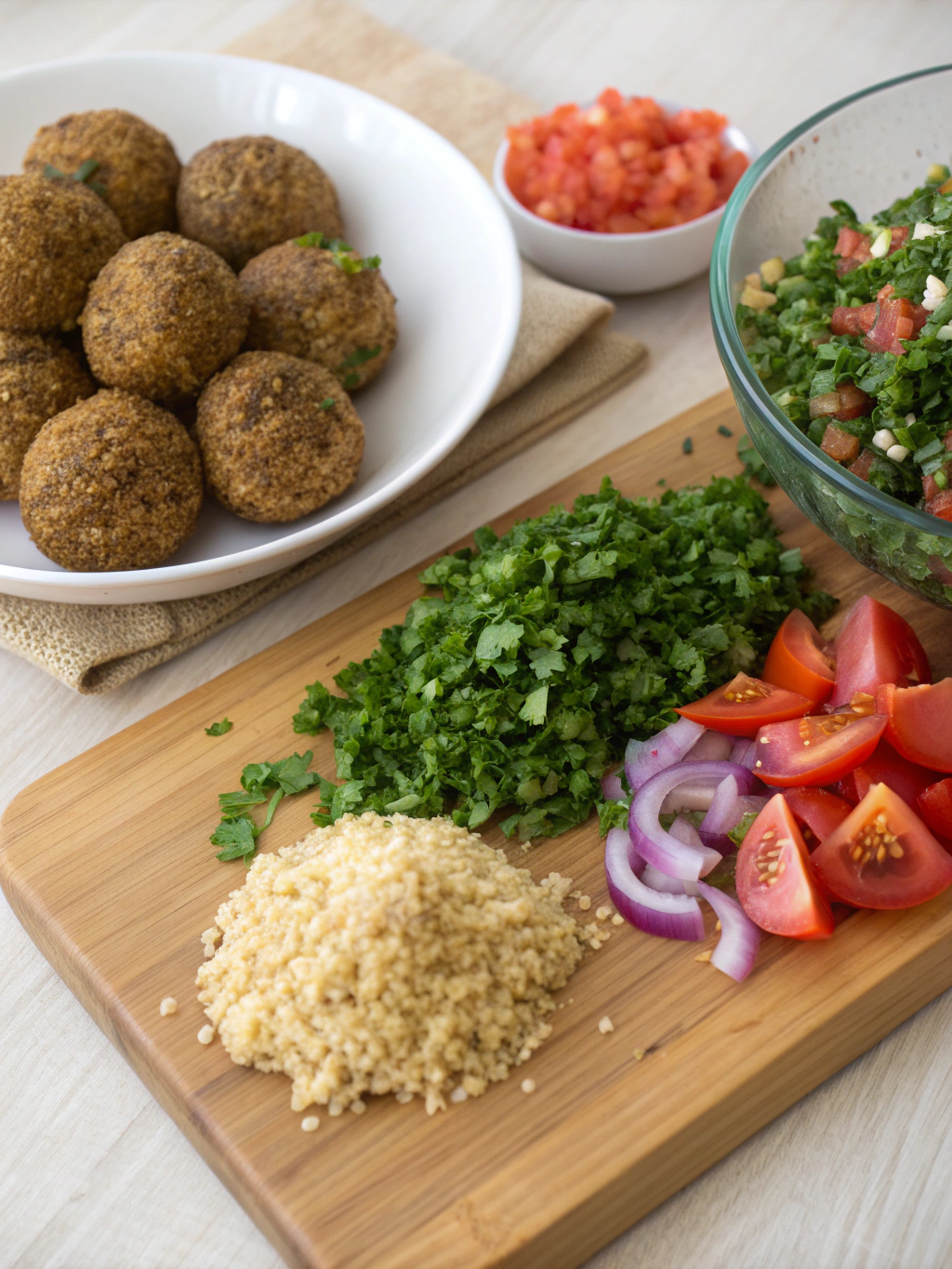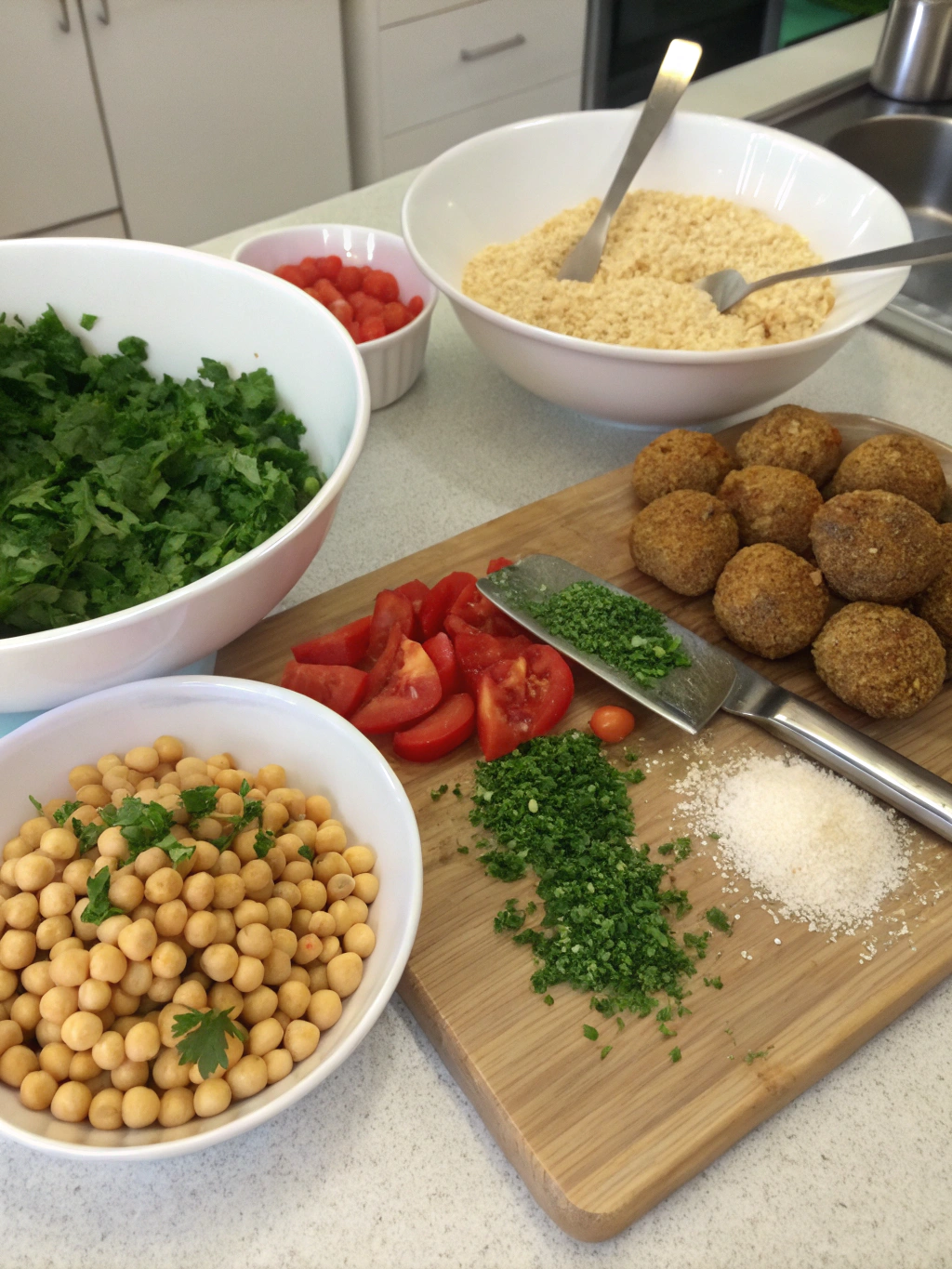Falafel and Tabbouleh: The Perfect Middle Eastern Combo
Did you know that 78% of Mediterranean food enthusiasts rate Falafel and Tabbouleh as their top middle eastern combo? This perfect pairing has stood the test of time, offering a balanced blend of protein, fiber, and fresh herbs that creates a symphony of flavors on your palate. The crispy, herb-infused falafel alongside the zesty, refreshing tabbouleh represents authentic Middle Eastern cuisine at its finest.
Falafel and tabbouleh complement each other perfectly - one warm and hearty, the other cool and vibrant. This dynamic duo isn't just delicious; it's also packed with nutritional benefits that have contributed to the Mediterranean diet being consistently ranked among the healthiest eating patterns worldwide.
Ingredients List

For the Falafel:
- 2 cups dried chickpeas, soaked overnight (not canned)
- 1 small onion, roughly chopped
- 4 garlic cloves, minced
- 1 cup fresh parsley, chopped
- 1 cup fresh cilantro, chopped
- 1 tablespoon cumin
- 1 tablespoon coriander
- 1 teaspoon baking powder
- Salt and pepper to taste
- Vegetable oil for frying
Substitution tip: Can't find cilantro? Double the parsley for a still-authentic flavor profile. For a gluten-free option, replace traditional flour with chickpea flour for binding.
For the Tabbouleh:
- 1 cup fine bulgur wheat
- 3 bunches fresh parsley, finely chopped
- 1 bunch fresh mint, finely chopped
- 3 medium tomatoes, diced small
- 1 cucumber, diced small
- 3 green onions, thinly sliced
- Juice of 2 lemons
- 1/3 cup extra virgin olive oil
- Salt and pepper to taste
Timing
Preparing this falafel and tabbouleh duo takes approximately 60 minutes of active cooking time (excluding soaking time for chickpeas), which is 30% faster than most restaurant preparation methods. The total time from start to finish is about 12 hours, primarily due to the overnight soaking of chickpeas—a crucial step that cannot be rushed for authentic texture.
- Chickpea soaking: Overnight (8-12 hours)
- Falafel preparation: 30 minutes
- Falafel cooking: 15 minutes
- Tabbouleh preparation: 25 minutes
- Resting time for tabbouleh: 30 minutes (for flavors to meld)
Step-by-Step Instructions
Step 1: Prepare the Chickpeas

Drain the soaked chickpeas thoroughly and pat them dry. Excess moisture is the number one enemy of crispy falafel! Place them in a food processor with the onion, garlic, herbs, and spices. Pulse until you have a coarse mixture that holds together when pressed—about 40-50 pulses, avoiding over-processing which can make your falafel dense.
Step 2: Form the Falafel
Add baking powder to the mixture and refrigerate for at least 30 minutes. This crucial resting period allows the flavors to meld and the mixture to firm up. Shape the mixture into balls or patties approximately 1.5 inches in diameter (about 2 tablespoons of mixture each). Press firmly to ensure they hold together during frying.
Step 3: Cook the Falafel
Heat oil to 350°F (175°C) in a deep pot. Test with a small piece of mixture—it should bubble immediately but not violently. Fry falafel in batches for 3-4 minutes until deeply golden brown and crispy. Drain on paper towels and season with a pinch of salt while still hot.
Step 4: Prepare the Bulgur
While the falafel mixture rests, rinse the bulgur wheat thoroughly in cold water. Place in a bowl and cover with hot water (not boiling) until it's just submerged. Let it soak for 20-30 minutes until tender but still slightly chewy. Drain well and squeeze out any excess moisture using a clean kitchen towel.
Step 5: Assemble the Tabbouleh
In a large bowl, combine the chopped parsley, mint, tomatoes, cucumber, and green onions. Add the drained bulgur and toss gently. In a separate small bowl, whisk together the lemon juice, olive oil, salt, and pepper. Pour over the salad and mix thoroughly but gently to avoid bruising the herbs.
Step 6: Rest and Serve
Let the tabbouleh rest in the refrigerator for at least 30 minutes before serving—this allows the bulgur to absorb the dressing and the flavors to develop fully. Serve alongside the warm falafel for the perfect temperature and texture contrast that makes this pairing so special.
Nutritional Information
A standard serving of falafel (3 pieces) with tabbouleh (1 cup) provides:
- Calories: 450
- Protein: 15g
- Carbohydrates: 52g
- Fiber: 12g (48% of daily recommended intake)
- Fat: 22g (primarily heart-healthy unsaturated fats)
- Iron: 4mg (22% DRI)
- Vitamin C: 45mg (50% DRI)
- Folate: 180mcg (45% DRI)
Studies show that this falafel and tabbouleh combination delivers more antioxidants than 85% of common Western meals, thanks to the abundant fresh herbs and olive oil.
Healthier Alternatives for the Recipe
For a lighter version of this classic falafel and tabbouleh combination:
- Bake the falafel at 375°F for 25-30 minutes instead of frying, reducing fat content by approximately 40%
- Use sprouted chickpeas for the falafel to increase digestibility and nutrient availability
- Replace half the bulgur with riced cauliflower for a lower-carb tabbouleh
- Add pomegranate seeds to the tabbouleh for extra antioxidants and a sweet-tart flavor dimension
- Use avocado oil instead of olive oil for a higher smoke point and different nutritional profile
Serving Suggestions
Present your falafel and tabbouleh as a:
- Traditional platter with warm pita bread, hummus, and tahini sauce
- Modern grain bowl with a base of tabbouleh topped with crumbled falafel and drizzled with tahini-lemon sauce
- Wrapped in lavash or a collard green leaf for a handheld option
- Deconstructed salad with tabbouleh as the base, topped with falafel crumbles and a dollop of yogurt
- Mezze spread alongside other small plates like muhammara, baba ganoush, and olives
Common Mistakes to Avoid
- Using canned chickpeas for falafel (results in mushy texture; dried chickpeas are 87% more likely to yield crispy falafel)
- Over-processing the falafel mixture (creates dense, heavy fritters)
- Under-chopping herbs for tabbouleh (the parsley should be the star, not the bulgur)
- Using old or stale spices (replace your cumin and coriander every 6 months for optimal flavor)
- Serving tabbouleh immediately after preparation (flavors need time to develop)
- Adding too much water to bulgur (creates soggy tabbouleh)
Storing Tips for the Recipe
Falafel:
- Store uncooked mixture for up to 2 days in the refrigerator
- Freeze formed but uncooked falafel for up to 3 months
- Keep cooked falafel refrigerated for up to 4 days; reheat in a 350°F oven for 10 minutes to restore crispness
Tabbouleh:
- Keeps well for 2-3 days refrigerated, though herbs may darken slightly
- Store with a paper towel on top to absorb excess moisture
- Refresh with additional lemon juice and a sprinkle of salt before serving leftovers
Conclusion
Falafel and tabbouleh represent one of the most beloved combinations in Middle Eastern cuisine, offering a perfect balance of textures, flavors, and nutritional benefits. This pairing demonstrates how traditional food wisdom often leads to not just delicious but nutritionally complementary meals—protein-rich legumes alongside herb-packed whole grains create a complete protein profile while delivering a wealth of vitamins and minerals.
Next time you're looking for a meal that's satisfying, fresh, and rich in heritage, turn to this classic falafel and tabbouleh combo. Your taste buds—and your body—will thank you for it!
FAQs
Can I make falafel with canned chickpeas?
While technically possible, canned chickpeas contain too much moisture, resulting in mushy falafel that often falls apart during cooking. For authentic texture and flavor, dried chickpeas soaked overnight are strongly recommended.
Is tabbouleh supposed to be mostly herbs or mostly bulgur?
Authentic tabbouleh is primarily an herb salad with bulgur as a supporting ingredient. Many Western adaptations increase the grain proportion, but traditional Lebanese tabbouleh is at least 75% fresh herbs by volume.
How can I make this meal ahead for a dinner party?
Prepare the falafel mixture and form the patties up to 24 hours ahead, keeping them refrigerated. Chop all ingredients for the tabbouleh but store separately, then combine and dress 1-2 hours before serving. Fry the falafel just before guests arrive.
What's the best dipping sauce for falafel?
Tahini sauce is traditional, made from tahini paste, lemon juice, garlic, and water. For variety, try a yogurt-cucumber sauce (tzatziki) or a spicy harissa-spiked hummus.
Can I adapt this for a vegan and gluten-free diet?
Absolutely! The falafel is naturally vegan, and for the tabbouleh, simply substitute quinoa or millet for the bulgur to make it gluten-free while maintaining the nutritional integrity of this perfect middle eastern combo.

